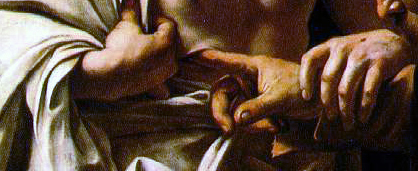Audio-book Review
By Chet Yarbrough
(Blog:awalkingdelight)
Website: chetyarbrough.blog
Caravaggio, A Life Sacred and Profane

By Andrew Graham-Dixon
Narrated by Edoardo Ballerini

Caravaggio is artists’ bad boy of early sixteenth century Italy. Born in 1571, Caravaggio arrives in the midst of religious turmoil between Catholic nations and the Ottoman Empire. Caravaggio comes to life in Andrew Graham-Dixon’s biography. Graham-Dixon explores the light and dark of Michelangelo Merisi Caravaggio’s short life.
Graham-Dixon suggests Caravaggio’s life is self-formed by circumstance of history, the political connection of Caravaggio’s family, and a rebellious nature of a boy who loses his father at the age of six. A self-formed life is a description of Caravaggio’s growth to manhood. It suggests Caravaggio’s artistic ability comes from inner drive more than formal education. Though Caravaggio is apprenticed to painters in his youth, contribution to his artistic ability is obscured by differences in what Caravaggio paints and what his teacher’s taught.

Use of light and shade (chiaroscuro) reflects an early break with what teachers taught and what Caravaggio could do. In his early work, the beginnings of Caravaggio’s genius are shown. Even though the subject “Boy Peeling Fruit” shows immature dimensional perspective, Caravaggio’s beginning use of light and dark dramatically highlights his subject. As time passes, Caravaggio skillfully improves chiaroscuro to further dramatize his work.
Graham-Dixon recounts Martin Scorsese’s 1960s comments about Caravaggio’s cinematic sense. Caravaggio’s paintings tell stories of the bible known by the public but known more symbolically than literally. Caravaggio’s work dramatizes biblical stories. The dramatic finger probe of Jesus by Thomas cinematically illustrates Christ has risen from the dead. From the frown on doubting Thomas’s face to Thomas’s dirty fingers, the biblical story becomes graphically real.

At times, Caravaggio went too far and displeased his benefactor with biblical interpretations that offended social propriety. In St. Matthew and the Angel, the intimacy of the angel and St. Mathew offended his client. A second version had to be painted before Caravaggio would be paid.


Caravaggio paints from models of working people of his time to make stories of the bible truer to Jesus’s time. Jesus walks among the poor, the bereft, and sinners of society. Caravaggio’s characters are workers, prostitutes (courtesans), and gamblers like “The Cardsharps…” or his sexualized “Cupid as Victor”. He shows the dirty feet of a visitor to “Madonna of Loreto”.


MADONNA OF LORRETO (Below shows the dirty feet of a visitor.)
Graham-Dixon’s infers Caravaggio is a profligate sinner himself. Caravaggio is described as a person who wears black to obscure his visage at night when he is raising hell with his friends and enemies. Caravaggio violates the law by carrying a sword without a license; by brawling in local brothels and practicing alleged bi-sexual acts. Graham-Dixon suggests Caravaggio may have been a pimp to subsidize his income. Graham-Dixon also suggests pimping may have provided models for his art. Finally, Caravaggio kills a man and is sentenced to death.
Caravaggio is recorded by witnesses and in trials to have a volatile temper. Though the biographer mentions artist’s behavior was sometimes affected by lead and other contaminants of their paint, Graham-Dixon does not conclude Caravaggio’s behavior is caused by a painter’s occupational hazard. In 2010, lead poisoning is found in what is believed to have been Caravaggio’s remains. But Graham-Dixon reports no one really knows exactly where Caravaggio is buried. Were those remains Caravaggio’s?

Graham-Dixon concludes the biography with an explanation of Caravaggio’s mysterious death. Caravaggio made many enemies, but no one knows for sure what caused his death. Graham-Dixon believes a vendetta, by a member of the Knights of Malta, is the proximate cause of Caravaggio’s death.
Caravaggio, when he tries to become a Knight of Malta to escape the death sentence for an earlier murder, insults one of the Knights. The insult goes unsatisfied and is compounded by Caravaggio’s abandonment of the Knights of Malta when he thinks he will get a pardon for his crimes from Rome. Graham-Dixon suggests the insulted Knight catches up with Caravaggio and severely cuts his face. Several months later, Caravaggio is still recovering from the wounds when notice comes to him–upon return to Rome, he will receive his pardon.
Caravaggio packs his bags and his last three paintings and heads for Rome. The trip is by ship. The voyage includes a stop before arriving in Rome. At the stop, for an unknown reason, Caravaggio is retained by a local sheriff. The boat sails without him. When Caravaggio is released, he buys a horse to meet the departed ship at its next port before Rome. Caravaggio is still recovering from his wounds. When he arrives at a port, he is sick unto death with fever and exhaustion. Some days later, he dies at the age of 38.
Caravaggio marked a pivot point in the meaning of art. Painting became more than symbolic representation, i.e., it became a cinematic representation of the real world. The imperfection of humankind, both physically and spiritually became a part of art’s story about life. Caravaggio’s art reflects on the violence of life, the imperfection of humankind, the doubts of human belief in God, and the nature of human beings.


Caravaggio’s use of light and dark is the principle challenge to a recently found work of art attributed to, but not signed by Caravaggio. The objection is related to the use of a brown backdrop that enhances the light and shade characteristic of Caravaggio’s paintings. The estimate value for the newly discovered version of JUDITH BEHEADING HOLFERNES is $100m.



One thought on “ARTISTS’ BAD BOY”